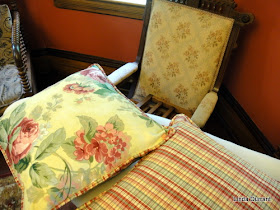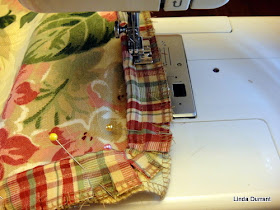Just a few pins to hold the pillow seam steady while I sew 1/8" blindstitches. Once the blindstitches are complete you can't see the piping stitches peaking through.
Cutting the Front and Back
The pillow forms were 18" squares. To make a perfect cover--I cut front and back panels at 19" square. That's the secret--always cut fabric one inch larger than the size of the pillow form. Next, I serged all four sides of each panel. Set panels to the side.
Preparing Piping
I used 3/8" cotton cord. It is soft, and turns effortlessly around corners--making for easy sewing.
Piping is a plaid fabric and cut 2-1/2" strips with a rotary cutter. I made 3 pillow covers, and each pillow requires two yards of piping, plus a tiny bit more to ease the corners. I purchased 6.5 yards of cotton cord. The plaid fabric was 56" wide, so I cut 5 strips, and joined the strips with the serger. Then I like to serge the entire length of the large plaid strip.
Using a zipper foot on my regular sewing machine I slipped the cotton cord into the plaid fabric strip, keeping the zipper foot snug against the cotton cord and stitch. I lengthen the stitch to 2.8 or 3.0 so the fit is relaxed.
After the piping is sewn, with scissors I snip every 1/2 inch along the entire strip length. Get a cup of coffee, sip often, and sing to pass the time while you make the snips, taking care not to snip too deep--staying clear of the stitch line. About 100 snips per yard. Snipping is boring, but honestly it is the most important step in getting the piping to mold around the panel--making it a breeze to sew.
The piping is pinned to the front panel. Place the piping to the edge of the fabric. I lay the front panel right side up, find center and begin to pin the piping. Above Photo--at the corner place pin, then
At the center of the corner place second pin, then
And now you can see placement of the third and fourth pin, continuing to pin every two inches until you reach the next corner and repeat.
As you pin and turn the corner, if you lift the fabric you can readily see how the piping will gently ease around the turn--confirming everything is pinned great.
At the left, see the white cotton cord. I exposed the cord by removing stitches back 1 inch.
I snipped off 1 inch of cotton cord. Notice the twisted cord wants to immediately unravel, and the 1 inch of cord I cut off looks like a chunk of white fluff. Pick it up and throw it over your shoulder for good luck!
When I straighten the left piping sleeve, the cotton cord retracts immediately. Fold the end of the raw material into the area where you snipped off the 1 inch of cotton cord. Then,
Here, I am holding the left piping sleeve open, and placing the right piping inside. The fit will be perfect.
With a stitch length of 2.8 to 3.0, stitch around the entire perimeter of the front panel.
IMPORTANT - The best kept secret is: remove pins several inches before you stitch.
Removing the pins as you stich will allow the snipped piping to relax and sit in perfect alignment.
Stitch to the middle of the corner, stop, put needle in the down position to hold the fabric, then pivot to make the turn and continue stitching removing pins as you go.
After you finish sewing the piping, place the back panel on top of the front panel with right sides together. Pin every 3 inches.
Using the zipper foot stitch snug to the piping cord around the perimeter. Be sure to leave an opening of 8-10" to slide a pillow form into position.
Close opening with blindstitches. Give it a try and have fun.
















Beautifully done Linda. Always fun to see what your up to.
ReplyDeleteAnyès
XX
Looks easy when you do it. I have a wonderful sweet sister that sews like a dream, all I do is ask, "PLEASE!" Thanks for sharing, Richard at My Old historic House
ReplyDeleteI like the striped piping with the floral fabric. Great instructions! I don't sew very often anymore. It would be really nice to have a serger! I still have my original Singer from 1971!
ReplyDelete-Pam